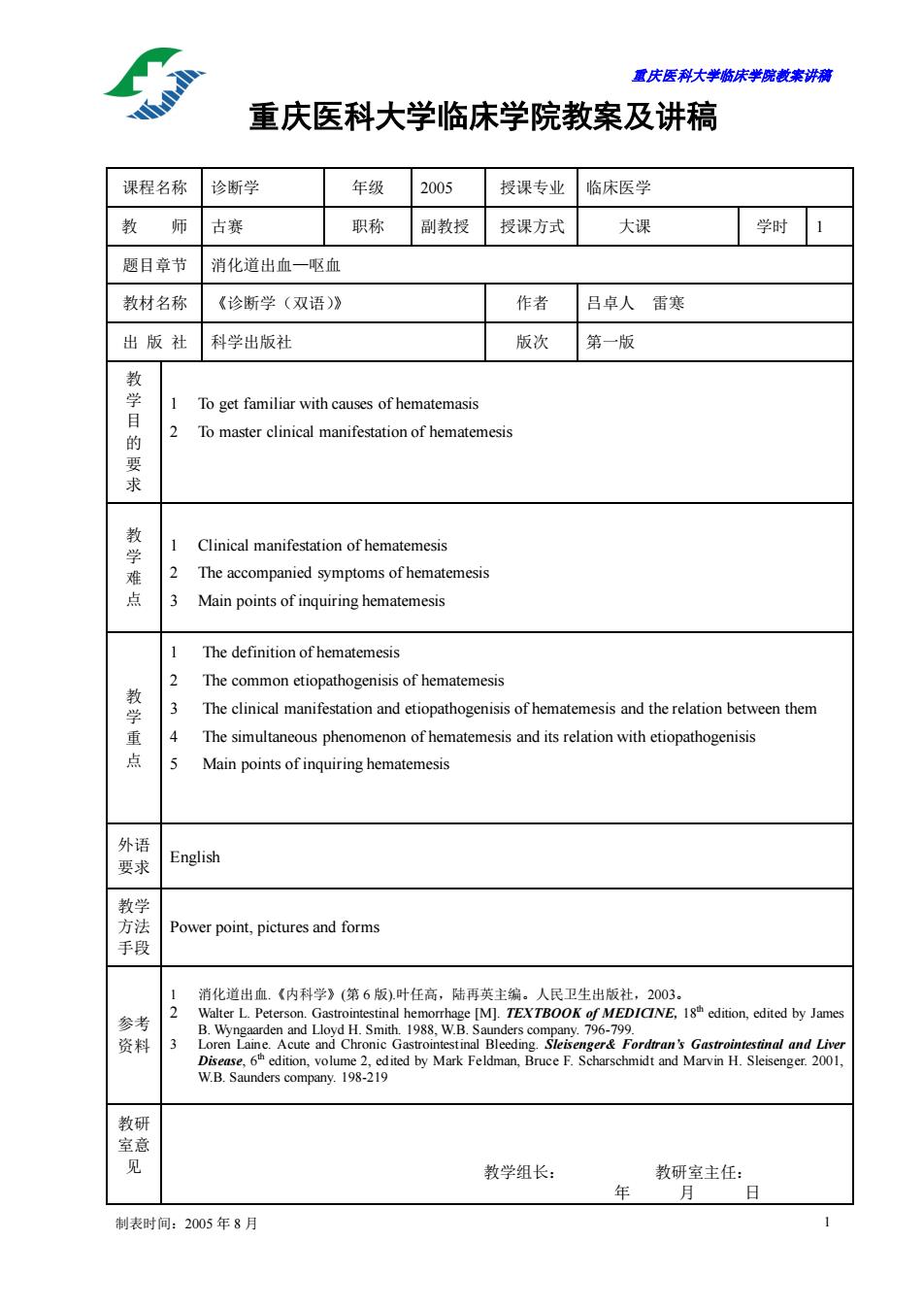
置庆医科大半脑床半院藏未讲满 重庆医科大学临床学院教案及讲稿 课程名称诊断学 年级2005授课专业临床医学 教师古赛 职称副教投授课方式 大课 学时1 题目章节消化道出血一呕血 教材名称《诊断学(双语)》 作者吕卓人雷寒 出版社科学出版社 版次第一版 教 To get familiar with causes of hematemasis 学目的要求 2 To master clinical manifestation of hematemesis 1 Clinical manifestation of hematemesis The accompanied symptoms ofhematemesis Main points of inquiring hematemesis The definition of hematemesis The common etiopathogenisis of hematemesis The clinca manifestation and etiopathogenisis of hematemesis and the reation between them 重点 The simultaneous phenomenon of hematemesis and its relation with etiopathogenisis Main points of inquiring hematemesis 外语 要求 English Power point,pictures and forms 手段 参考 资料 教研 教学组长 年 教研室主任 日 制表时间:2005年8月
重庆医科大学临床学院教案讲稿 制表时间:2005 年 8 月 1 重庆医科大学临床学院教案及讲稿 课程名称 诊断学 年级 2005 授课专业 临床医学 教 师 古赛 职称 副教授 授课方式 大课 学时 1 题目章节 消化道出血—呕血 教材名称 《诊断学(双语)》 作者 吕卓人 雷寒 出 版 社 科学出版社 版次 第一版 教 学 目 的 要 求 1 To get familiar with causes of hematemasis 2 To master clinical manifestation of hematemesis 教 学 难 点 1 Clinical manifestation of hematemesis 2 The accompanied symptoms of hematemesis 3 Main points of inquiring hematemesis 教 学 重 点 1 The definition of hematemesis 2 The common etiopathogenisis of hematemesis 3 The clinical manifestation and etiopathogenisis of hematemesis and the relation between them 4 The simultaneous phenomenon of hematemesis and its relation with etiopathogenisis 5 Main points of inquiring hematemesis 1. mesis 外语 要求 English 教学 方法 手段 Power point, pictures and forms 参考 资料 1 消化道出血.《内科学》(第 6 版).叶任高,陆再英主编。人民卫生出版社,2003。 2 Walter L. Peterson. Gastrointestinal hemorrhage [M]. TEXTBOOK of MEDICINE, 18th edition, edited by James B. Wyngaarden and Lloyd H. Smith. 1988, W.B. Saunders company. 796-799. 3 Loren Laine. Acute and Chronic Gastrointestinal Bleeding. Sleisenger& Fordtran’s Gastrointestinal and Liver Disease, 6th edition, volume 2, edited by Mark Feldman, Bruce F. Scharschmidt and Marvin H. Sleisenger. 2001, W.B. Saunders company. 198-219 教研 室意 见 教学组长: 教研室主任: 年 月 日
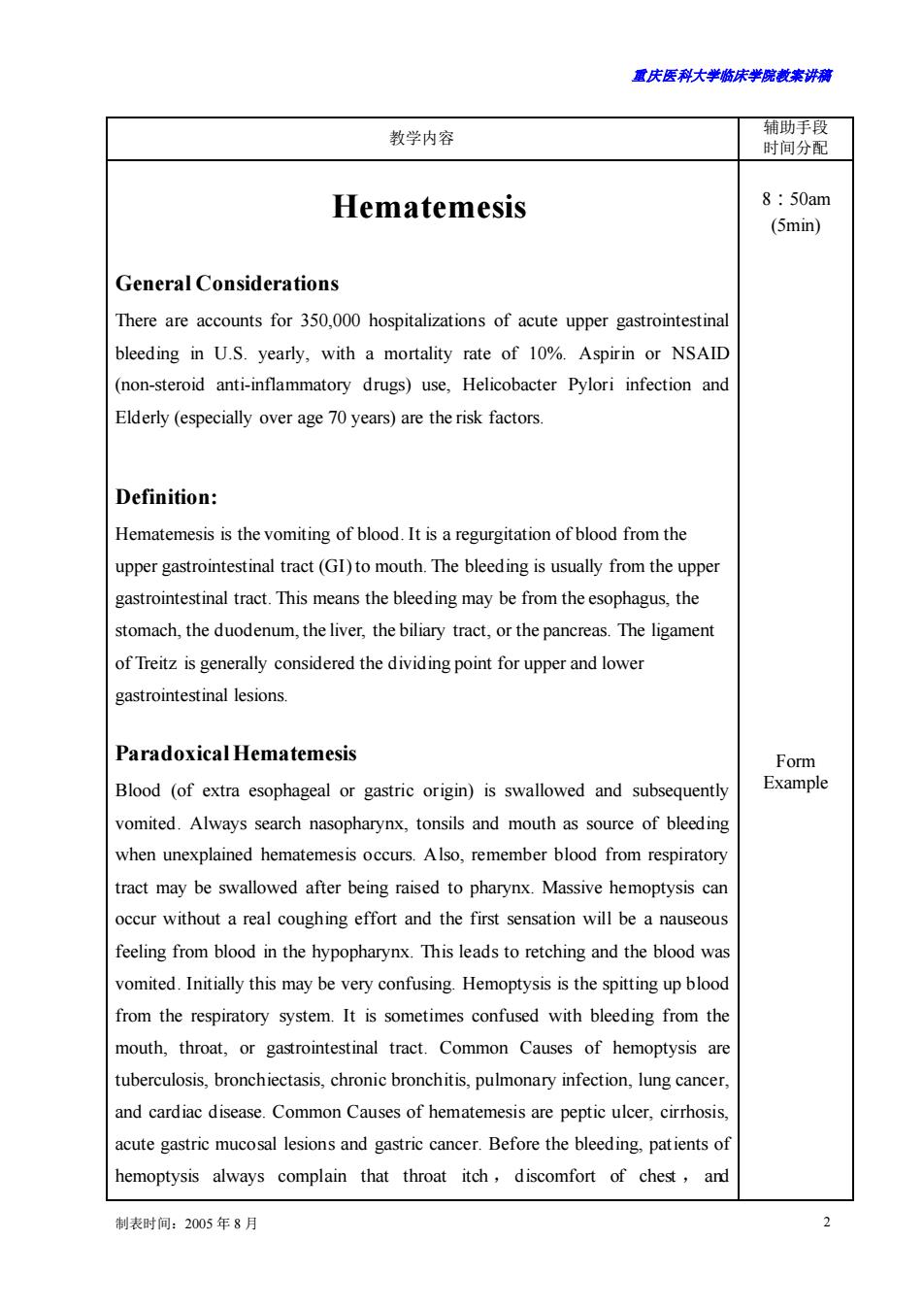
露庆医科大学临床半蕊载案讲满 教学内容 Hematemesis 8:50am (5min) General Considerations There are accounts for 350,000 hospitalizations of acute upper gastrointestinal bleeding in U.S.yearly,with a mortality rate of 10%.Aspirin or NSAID (non-steroid anti-inflammatory drugs)use,Helicobacter Pylori infection and Elderly (especially over age 70 years)are the risk factors. Definition: Hematemesis is the vomiting of blood.It is a regurgitation of blood from the upper gastrointestinal tract(GI)to mouth.The bleeding is usually from the upper gastrointestinal tract.This means the bleeding may be from the esophagus,the stomach,the duodenum,the liver,the biliary tract,or the pancreas.The ligament of Treitz is generally considered the dividing point for upper and lower gastrointestinal lesions. Paradoxical Hematemesis Blood (of extra esophageal or gastric origin)is swallowed and subsequently me vomited.Always search nasopharynx,tonsils and mouth as source of bleeding when unexplained hematemesis occurs.Also,remember blood from respiratory tract may be swallowed after being raised to pharynx.Massive hemoptysis can occur without a real coughing effort and the first sensation will be a nauseous feeling from blood in the hypopharynx.This leads to retching and the blood was vomited.Initially this may be very confusing Hemoptysis is the spitting up bloo from the respiratory system.It is sometimes confused with bleeding from the mouth,throat,or gastrointestinal tract.Common Causes of hemoptysis ar tuberculosis,bronchiectasis,chronic bronchitis,pulmonary infection,lung cancer and cardiac disease.Common Causes of hematemesis are peptic ulcer,cirrhosis acute gastric mucosal lesions and gastric cancer.Before the bleeding,patients of hemoptysis always complain that throat itch,discomfort of chest,and 制表时间:2005年8月
重庆医科大学临床学院教案讲稿 制表时间:2005 年 8 月 2 教学内容 辅助手段 时间分配 Hematemesis General Considerations There are accounts for 350,000 hospitalizations of acute upper gastrointestinal bleeding in U.S. yearly, with a mortality rate of 10%. Aspirin or NSAID (non-steroid anti-inflammatory drugs) use, Helicobacter Pylori infection and Elderly (especially over age 70 years) are the risk factors. Definition: Hematemesis is the vomiting of blood. It is a regurgitation of blood from the upper gastrointestinal tract (GI) to mouth. The bleeding is usually from the upper gastrointestinal tract. This means the bleeding may be from the esophagus, the stomach, the duodenum, the liver, the biliary tract, or the pancreas. The ligament of Treitz is generally considered the dividing point for upper and lower gastrointestinal lesions. Paradoxical Hematemesis Blood (of extra esophageal or gastric origin) is swallowed and subsequently vomited. Always search nasopharynx, tonsils and mouth as source of bleeding when unexplained hematemesis occurs. Also, remember blood from respiratory tract may be swallowed after being raised to pharynx. Massive hemoptysis can occur without a real coughing effort and the first sensation will be a nauseous feeling from blood in the hypopharynx. This leads to retching and the blood was vomited. Initially this may be very confusing. Hemoptysis is the spitting up blood from the respiratory system. It is sometimes confused with bleeding from the mouth, throat, or gastrointestinal tract. Common Causes of hemoptysis are tuberculosis, bronchiectasis, chronic bronchitis, pulmonary infection, lung cancer, and cardiac disease. Common Causes of hematemesis are peptic ulcer, cirrhosis, acute gastric mucosal lesions and gastric cancer. Before the bleeding, patients of hemoptysis always complain that throat itch , discomfort of chest , and 8:50am (5min) Form Example
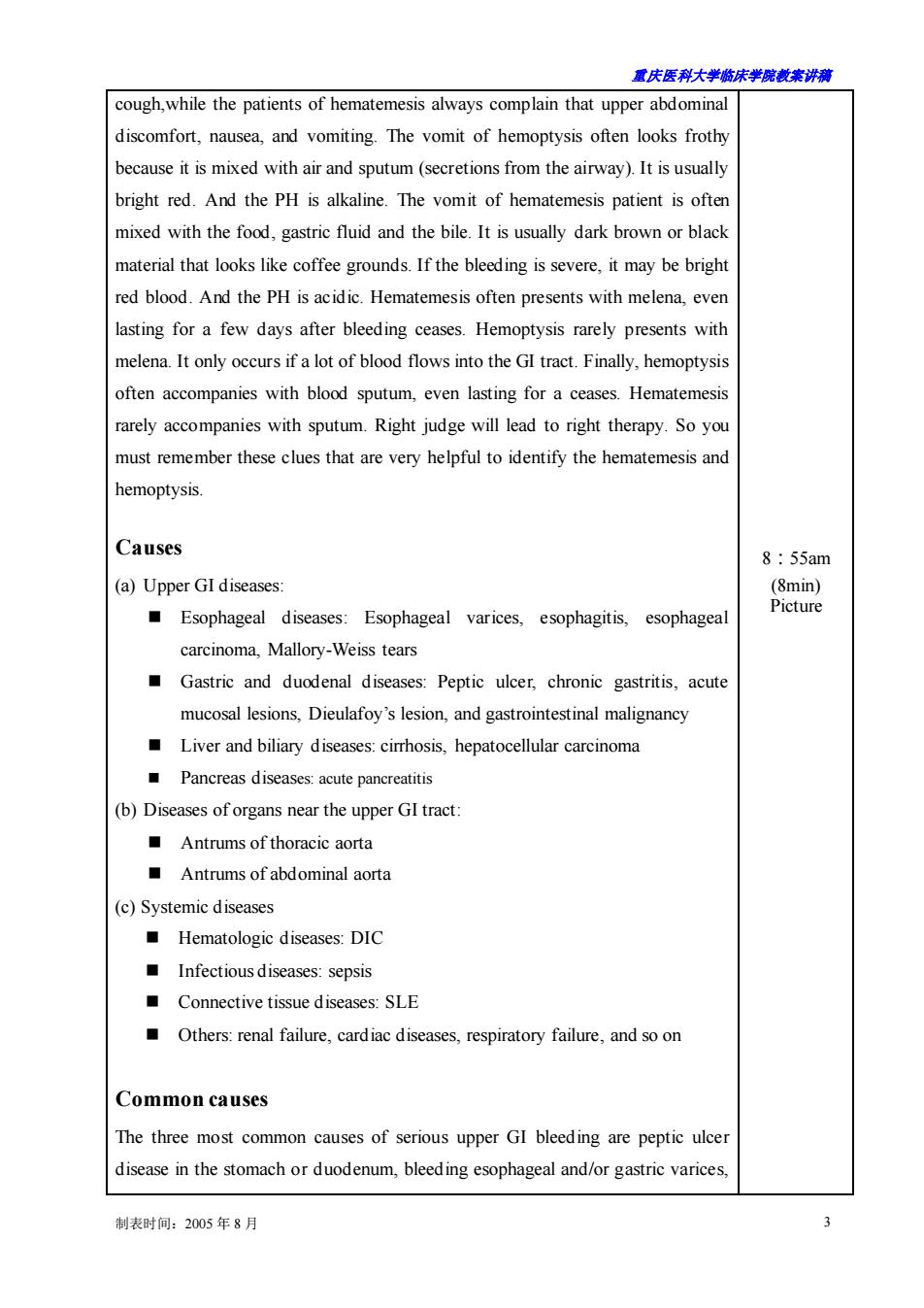
置庆医科大半脑床半鹿藏未讲满 cough,while the patients of hematemesis always complain that upper abdominal discomfort,nausea,and vomiting.The vomit of hemoptysis often looks frothy because it is mixed with air and sputum(secretions from the airway).It is usually bright red.And the PH is alkaline.The vomit of hematemesis patient is often mixed with the food,gastric fluid and the bile.It is usually dark brown or black material that looks like coffee grounds.If the bleeding is severe,it may be bright ed blood.And the PH is acidic.Hematemesis often presents with melena,ever asting for a few days after bleeding ceases.Hemoptysis rarely presents with melena.It only occurs if a lot of blood flows into the GI tract.Finally,hemoptysis often accompanies with blood sputum,even lasting for a ceases.Hematemesis rarely accompanies with sputum.Right judge will lead to right therapy.So you must remember these clues that are very helpful to identify the hematemesis and hemoptysis. Causes 8:55am (a)Upper GI diseases: Esophageal diseases:Esophageal varices,esophagitis,esophagea carcinoma,Mallory-Weiss tears Gastric and duodenal diseases:Peptic ulcer,chronic gastritis,acut mucosal lesions,Dieulafoy's lesion,and gastrointestinal malignancy Liver and biliary diseases:cirrhosis,hepatocellular carcinoma Pancreas diseases:acute pancreatitis (b)Diseases of organs near the upper GI tract: Antrums of thoracic aorta Antrums of abdominal aorta (c)Systemicdiseases Hematologic diseases:DIC Connective tissue diseases:SLE Others:renal failure,cardiac diseases,respiratory failure,and so on Common causes The three most common causes of serious upper GI bleeding are peptic ulce disease in the stomach or duodenum,bleeding esophageal and/or gastric varices 制表时间:2005年8月
重庆医科大学临床学院教案讲稿 制表时间:2005 年 8 月 3 cough,while the patients of hematemesis always complain that upper abdominal discomfort, nausea, and vomiting. The vomit of hemoptysis often looks frothy because it is mixed with air and sputum (secretions from the airway). It is usually bright red. And the PH is alkaline. The vomit of hematemesis patient is often mixed with the food, gastric fluid and the bile. It is usually dark brown or black material that looks like coffee grounds. If the bleeding is severe, it may be bright red blood. And the PH is acidic. Hematemesis often presents with melena, even lasting for a few days after bleeding ceases. Hemoptysis rarely presents with melena. It only occurs if a lot of blood flows into the GI tract. Finally, hemoptysis often accompanies with blood sputum, even lasting for a ceases. Hematemesis rarely accompanies with sputum. Right judge will lead to right therapy. So you must remember these clues that are very helpful to identify the hematemesis and hemoptysis. Causes (a) Upper GI diseases: ◼ Esophageal diseases: Esophageal varices, esophagitis, esophageal carcinoma, Mallory-Weiss tears ◼ Gastric and duodenal diseases: Peptic ulcer, chronic gastritis, acute mucosal lesions, Dieulafoy’s lesion, and gastrointestinal malignancy ◼ Liver and biliary diseases: cirrhosis, hepatocellular carcinoma ◼ Pancreas diseases: acute pancreatitis (b) Diseases of organs near the upper GI tract: ◼ Antrums of thoracic aorta ◼ Antrums of abdominal aorta (c) Systemic diseases ◼ Hematologic diseases: DIC ◼ Infectious diseases: sepsis ◼ Connective tissue diseases: SLE ◼ Others: renal failure, cardiac diseases, respiratory failure, and so on Common causes The three most common causes of serious upper GI bleeding are peptic ulcer disease in the stomach or duodenum, bleeding esophageal and/or gastric varices, 8:55am (8min) Picture
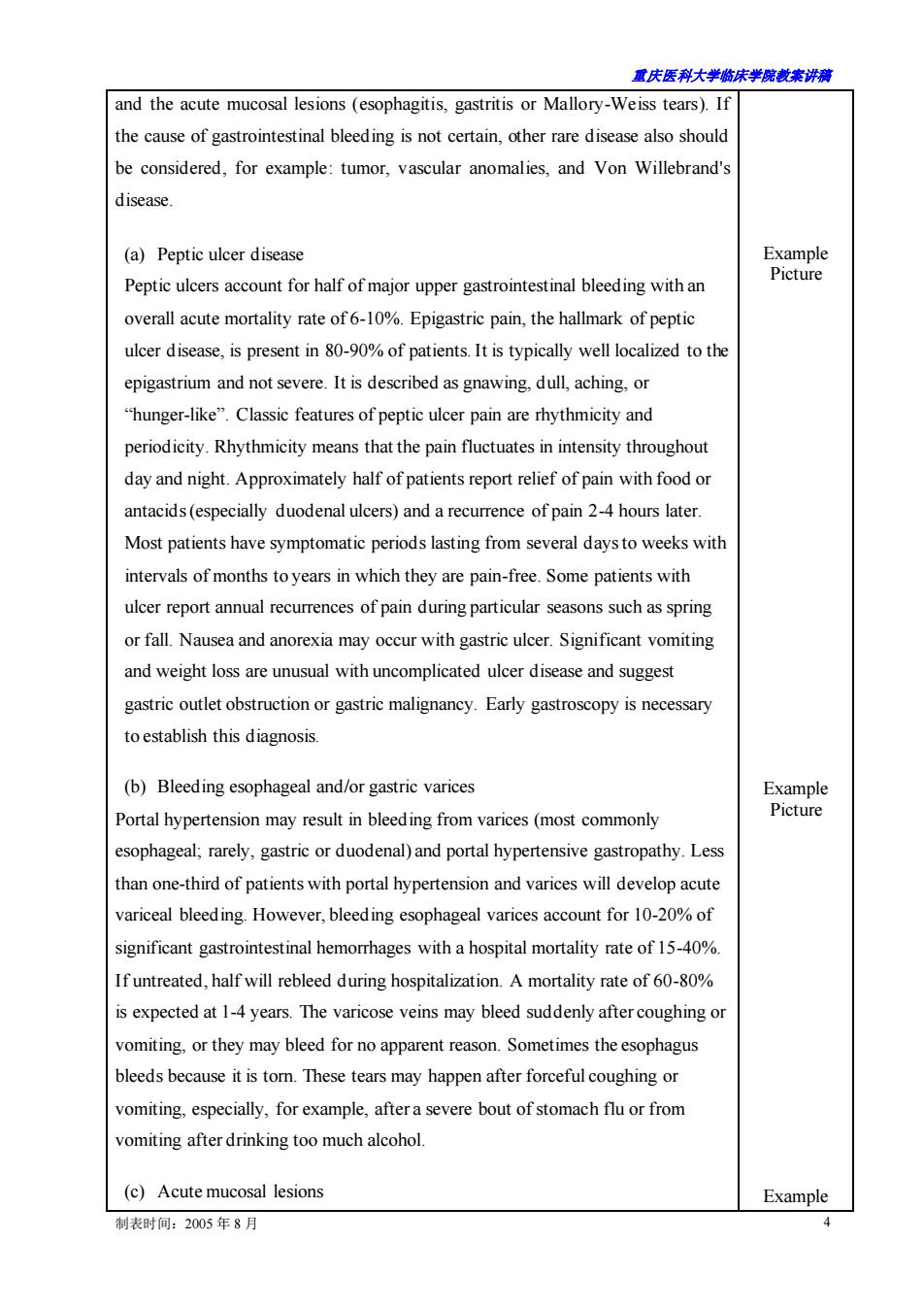
重庆医科大学临床半院载来讲满 and the acute mucosal lesions (esophagitis,gastritis or Mallory-Weiss tears).If the cause of gastrointestinal bleeding is not certain,other rare disease also should be considered,for example:tumor,vascular anomalies,and Von Willebrand's disease. (a)Peptic ulcer disease Example Peptic ulcers account for half of major upper gastrointestinal bleeding with an Picture overall acute mortality rate of6-10%.Epigastric pain,the hallmark of peptic ulcer disease,is present in 8-90%of patients.It is typically well localized to th epigastrium and not severe.It is described as gnawing.dull,aching.or "hunger-like"Classic features of peptic ulcer pain are rhythmicity and periodicity.Rhythmicity means that the pain fluctuates in intensity throughout day and night.Approximately half of patients report relief of pain with food or antacids(especially duodenal ulcers)and a recurrence of pain 2-4 hours later. Most patients have symptomatic periods lasting from several days to weeks with intervals of months to years in which they are pain-free.Some patients with ulcer report annual recurrences of pain during particular seasons such as spring or fall.Nausea and anorexia may occur with gastric ulcer.Significant vomiting and weight loss are unusual with uncomplicated ulcer disease and suggest gastric outlet obstruction or gastric malignancy.Early gastroscopy is necessary toestablish this diagnosis. (b)Bleeding esophageal and/or gastric varices Example Portal hypertension may result in bleeding from varices(most commonly Picture esophageal;rarely,gastric or duodenal)and portal hypertensive gastropathy.Less han one-third of patients with portal hypertension and varices will develop acute ariceal bleeding.However,bleeding esophageal varices account for 10-20%of significant gastrointestinal hemorhages with a hospital mortality rate of15-0% Ifuntreated,halfwill rebleed during hospitalization.A mortality rate of60-80% is expected at 1-4 years.The varicose veins may bleed suddenly after coughingo vomiting.or they may bleed for no apparent reason.Sometimes the esophagus bleeds because it is tom.These tears may happen after forceful coughing or vomiting,especially,for example,after a severe bout of stomach flu or from vomiting after drinking too much alcohol. (c)Acute mucosal lesions Example 制表时间:2005年8月 4
重庆医科大学临床学院教案讲稿 制表时间:2005 年 8 月 4 and the acute mucosal lesions (esophagitis, gastritis or Mallory-Weiss tears). If the cause of gastrointestinal bleeding is not certain, other rare disease also should be considered, for example: tumor, vascular anomalies, and Von Willebrand's disease. (a) Peptic ulcer disease Peptic ulcers account for half of major upper gastrointestinal bleeding with an overall acute mortality rate of 6-10%. Epigastric pain, the hallmark of peptic ulcer disease, is present in 80-90% of patients. It is typically well localized to the epigastrium and not severe. It is described as gnawing, dull, aching, or “hunger-like”. Classic features of peptic ulcer pain are rhythmicity and periodicity. Rhythmicity means that the pain fluctuates in intensity throughout day and night. Approximately half of patients report relief of pain with food or antacids (especially duodenal ulcers) and a recurrence of pain 2-4 hours later. Most patients have symptomatic periods lasting from several days to weeks with intervals of months to years in which they are pain-free. Some patients with ulcer report annual recurrences of pain during particular seasons such as spring or fall. Nausea and anorexia may occur with gastric ulcer. Significant vomiting and weight loss are unusual with uncomplicated ulcer disease and suggest gastric outlet obstruction or gastric malignancy. Early gastroscopy is necessary to establish this diagnosis. (b) Bleeding esophageal and/or gastric varices Portal hypertension may result in bleeding from varices (most commonly esophageal; rarely, gastric or duodenal) and portal hypertensive gastropathy. Less than one-third of patients with portal hypertension and varices will develop acute variceal bleeding. However, bleeding esophageal varices account for 10-20% of significant gastrointestinal hemorrhages with a hospital mortality rate of 15-40%. If untreated, half will rebleed during hospitalization. A mortality rate of 60-80% is expected at 1-4 years. The varicose veins may bleed suddenly after coughing or vomiting, or they may bleed for no apparent reason. Sometimes the esophagus bleeds because it is torn. These tears may happen after forceful coughing or vomiting, especially, for example, after a severe bout of stomach flu or from vomiting after drinking too much alcohol. (c) Acute mucosal lesions Example Picture Example Picture Example
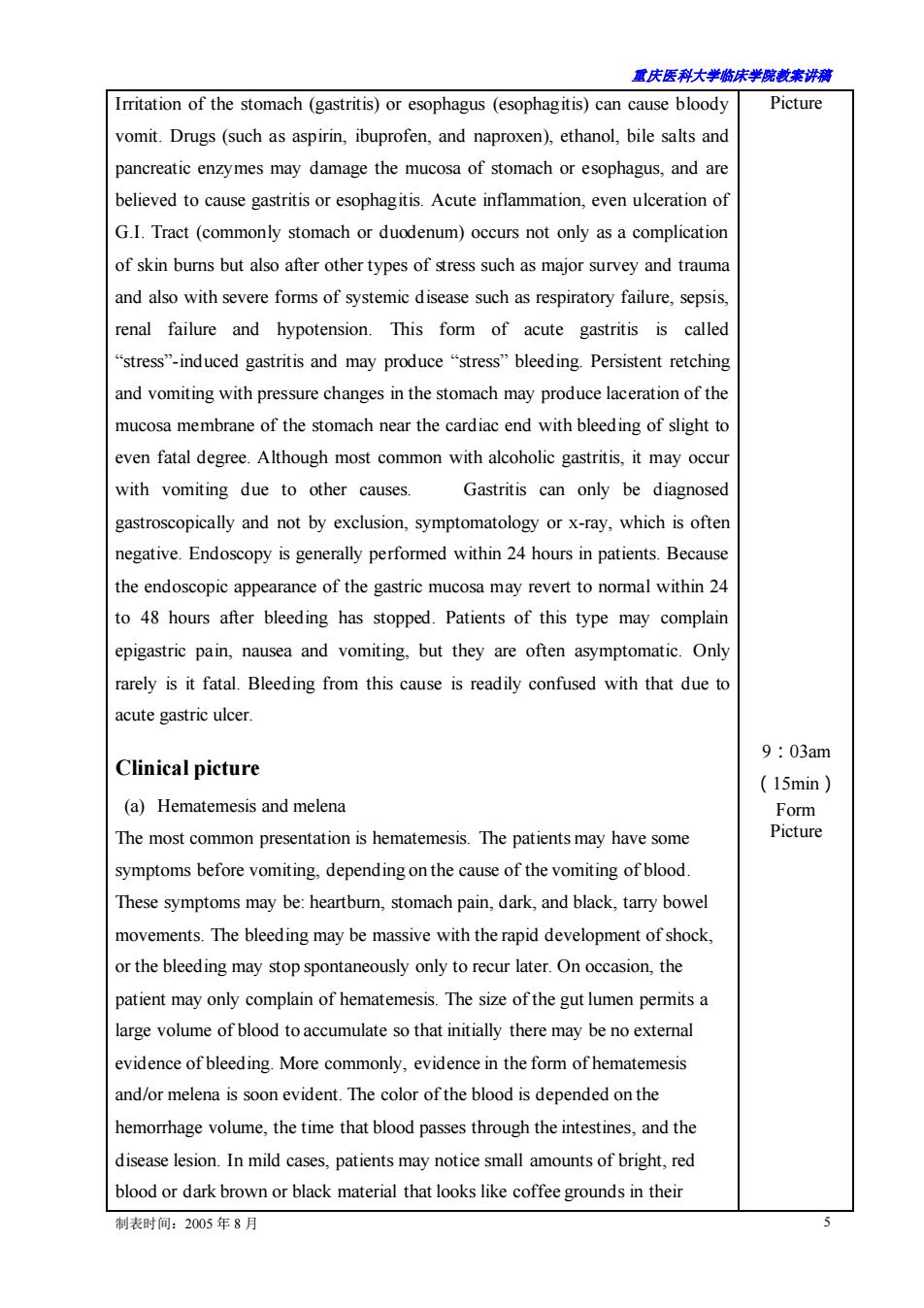
置庆医科大半脑床半鹿藏未讲满 Irritation of the stomach(gastritis)or esophagus (esophagitis)can cause bloody Picture vomit.Drugs(such as aspirin,ibuprofen,and naproxen),ethanol,bile salts and pancreatic enzymes may damage the mucosa of stomach or esophagus,and are believed to cause gastritis or esophagitis.Acute inflammation,even ulceration of G.I.Tract (commonly stomach or duodenum)occurs not only as a complication of skin burns but also after other types of stress such as major survey and trauma and also with severe forms of systemic disease such as respiratory failure,sepsis. renal failure and hypotension.This form of acute gastritis is called "stress"induced gastritis and may produce"stress"bleeding Persistent retching and vomiting with pressure changes in the stomach may produce laceration of the mucosa membrane of the stomach near the cardiac end with bleeding of slight to even fatal degree.Although most common with alcoholic gastritis,it may occur with vomiting due to other causes.Gastritis can only be diagnosed gastroscopically and not by exclusion,symptomatology or x-ray,which is often negative.Endoscopy is generally performed within 24 hours in patients.Because the endoscopic appearance of the gastric mucosa may revert to normal within 24 o 48 hours after bleeding has stopped.Patients of this type may complair epigastric pain,nausea and vomiting.but they are often asymptomatic.Only arely is it fatal.Bleeding from this cause is readily confused with that due to acute gastric ulcer. 9:03am Clinical picture (15min) (a)Hematemesis and melena Form The most common presentation is hematemesis.The patients may have some Picture symptoms before vomiting.depending on the cause of the vomiting of blood. These symptoms may be:heartbum,stomach pain,dark,and black,tarry bowel movements.The bleeding may be massive with the rapid development of shock. or the bleeding may stop spontaneously only to recur later.On occasion,the patient may only complain of hematemesis.The size of the gut lumen permits a large volume of blood to accumulate so that initially there may be no extemal evidence of bleeding.More commonly,evidence in the form of hematemesis nd/or melena is soon evident.The color of the blood is depended on the hemorhage volume,the time that blood passes through the intestines,and the disease lesion.In mild cases,patients may notice small amounts of bright,red blood or dark brown or black material that looks like coffee grounds in their 制表时间:2005年8月
重庆医科大学临床学院教案讲稿 制表时间:2005 年 8 月 5 Irritation of the stomach (gastritis) or esophagus (esophagitis) can cause bloody vomit. Drugs (such as aspirin, ibuprofen, and naproxen), ethanol, bile salts and pancreatic enzymes may damage the mucosa of stomach or esophagus, and are believed to cause gastritis or esophagitis. Acute inflammation, even ulceration of G.I. Tract (commonly stomach or duodenum) occurs not only as a complication of skin burns but also after other types of stress such as major survey and trauma and also with severe forms of systemic disease such as respiratory failure, sepsis, renal failure and hypotension. This form of acute gastritis is called “stress”-induced gastritis and may produce “stress” bleeding. Persistent retching and vomiting with pressure changes in the stomach may produce laceration of the mucosa membrane of the stomach near the cardiac end with bleeding of slight to even fatal degree. Although most common with alcoholic gastritis, it may occur with vomiting due to other causes. Gastritis can only be diagnosed gastroscopically and not by exclusion, symptomatology or x-ray, which is often negative. Endoscopy is generally performed within 24 hours in patients. Because the endoscopic appearance of the gastric mucosa may revert to normal within 24 to 48 hours after bleeding has stopped. Patients of this type may complain epigastric pain, nausea and vomiting, but they are often asymptomatic. Only rarely is it fatal. Bleeding from this cause is readily confused with that due to acute gastric ulcer. Clinical picture (a) Hematemesis and melena The most common presentation is hematemesis. The patients may have some symptoms before vomiting, depending on the cause of the vomiting of blood. These symptoms may be: heartburn, stomach pain, dark, and black, tarry bowel movements. The bleeding may be massive with the rapid development of shock, or the bleeding may stop spontaneously only to recur later. On occasion, the patient may only complain of hematemesis. The size of the gut lumen permits a large volume of blood to accumulate so that initially there may be no external evidence of bleeding. More commonly, evidence in the form of hematemesis and/or melena is soon evident. The color of the blood is depended on the hemorrhage volume, the time that blood passes through the intestines, and the disease lesion. In mild cases, patients may notice small amounts of bright, red blood or dark brown or black material that looks like coffee grounds in their Picture 9:03am (15min) Form Picture